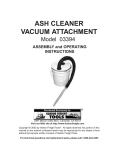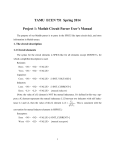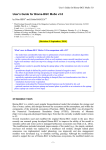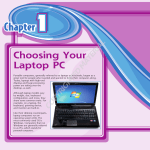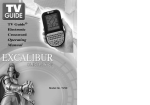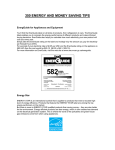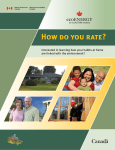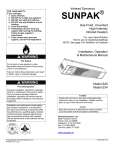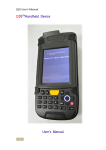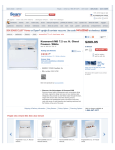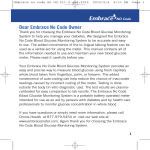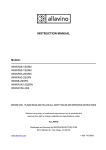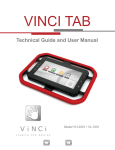Download Energy Efficiency Guide - Government of New Brunswick
Transcript
C arrying out day-to-day and weekend activities requires the use of energy. Whether you are taking a hot shower, tossing a load of laundry in the dryer, or working with power tools on a household project, these are just some of the many activities that require energy consumption. What you might not be aware of is that when fossil fuels are burned to produce energy, a mixture of gases and particles are released into the air. Some of these gases, such as sulphur dioxide and nitrogen oxides, are pollutants and others, such as carbon dioxide and methane, are greenhouse gases. As more and more of these gases are released into the air, they accumulate and cause global average temperatures to increase, adding to the effects of Climate Change. Signs of Climate Change are becoming more and more visible through odd weather patterns such as droughts, forest fires, and rising sea levels, all of which can have widereaching impacts on both human and animal life. So, you might be thinking, “What can I do about all of this?” The answer is--“plenty.” Because we’ve come to rely on so many energy driven services, like cars, refrigerators and dishwashers, it would be difficult to completely give up these conveniences. But, monitoring your energy use and, when possible, cutting back here and there can help to use energy more efficiently. It all adds up, and just think, you’ll be helping the environment and putting a little cash back in your pocket by saving on your heat and electrical bills! Read on to learn about the many ways in which you can save energy in and around your home. HOME HEATING Because of New Brunswick’s climate, we rely on heat for a substantial part of the year. Approximately 60% of the energy used in your home is for heating, so actions that reduce home heating requirements will have the most impact. Try the following suggestions to reduce energy consumption: • Consider converting to either an air source heat pump or high efficiency furnace, if your existing heating system needs replacement. Ground or geothermal heat pumps are the most efficient. • Check your electric baseboard thermostats for accuracy a couple of times a year. Faulty and inaccurate thermostats are a common cause for high heating bills. How to Check For Thermostat Accuracy Measure your room temperature with an indoor thermometer. Be sure to place it near your room thermostat. Turn your thermostat down and immediately turn it up until you hear a ‘click’. Myth: Leaving your thermostat at the same temperature night and day uses less energy than turning it down at night and up in the morning. Truth: It takes less energy to warm up a cool room than to heat it consistently. Lowering your thermostat at night, and when the house is unoccupied for more than 4-5 hours, can trim home heating bills by up to 10% and reduce emissions by up to half a tonne! (Note: Every 1ºC you lower your thermostat, you save 2% on your heating bill. Turning the thermostat back 5ºC, for example from 20ºC to 15ºC at nighttime, will reduce your heating costs by approximately 10% for that 8 hour period.) Note the temperature at which your thermostat turns on and measure it against the temperature indicated by the indoor thermometer. If the temperature of the thermostat differs by more than 2° C from the thermometer, consider adjusting your heat accordingly or replacing your thermostat with a high efficiency model. • Use programmable thermostats to automatically set back the temperature in those frequently used areas of the house, such as the kitchen and family room. • Reduce the temperature and close off unused rooms. During extremely cold weather, it might be necessary to increase the thermostat slightly to prevent condensation, mold and mildew. • Keep air registers and baseboard heaters clean and free of dust. • Clean or replace furnace filters regularly and have the furnace serviced yearly. • Consider putting an extra blanket on the bed instead of using an electric blanket. • Install fences, evergreen hedges and trees as energy saving windbreaks on the northwest side of your home. • Retrofit your house by adding insulation, weather stripping and caulking. Uninsulated basements can account for up to 30% (and sometimes more) of heat loss in the home. • Assess your house for air leaks using a thin piece of tissue. Check for drafts by holding the tissue near doors, vents or electrical outlets to see if it flutters. For best results, test for air leaks on a very cold or windy day. In many houses, a few simple measures can cut air leakage in half! LIGHTING With an average of 30 light bulbs in a typical Canadian home, it's easy to see how our energy consumption adds up. Following these tips may help you use your lighting energy more wisely. • Use lower wattage bulbs in areas that don’t require much light, such as hallways and storage spaces. Myth: Cleaning light fixtures and light bulbs is a waste of time and has no effect on light efficiency. Truth: You should clean fixtures and bulbs at least once a year since dust and dirt can lower efficiency and lighting levels. Be sure to unplug the fixture or turn the power off and wait until bulbs are cool-to-thetouch before cleaning. • Use a single 100 watt bulb rather than two 60 watt bulbs. It will give the same amount of light but requires less energy and costs less to purchase. • Install a timer to turn lights on at dusk and off at midnight. How to Beat a Draft If drafts are detected, consider the following to reduce heat loss: • Install motion sensor lighting for safety and security. Weatherstrip and caulk windows and doors where you detect drafts, and replace any worn weatherstripping. • Use night-lights as an efficient alternative to leaving lights on all night. Condensation between interior window-panes is an indication of air leakage and can be reduced with weatherstripping and by covering windows with clear plastic sheeting. • Consider switching from incandescent to compact fluorescent light bulbs (CFLs). They last up to 10 times longer and a 15 watt CFL will provide the same amount of light as a 60 watt incandescent while using 75% less energy! Always look for bulbs with the ENERGY STAR® symbol. During winter months, close drapes, blinds and shutters at night to reduce heat loss and open during the day to gain solar heat. Install well-fitting storm windows and doors, they can reduce heat loss by as much as 15%. Close the damper on your fireplace or woodstove when not in use. Install foam gaskets and plastic plugs in all electrical outlets and switches on outside walls. Upgrade insulation levels. The higher the R-Value of an insulating material, the greater the resistance to heat loss. NB Power recommends a minimum of R-40 for the attic, R-20 for the basement walls and R-20 for the exterior walls. In order to get the most efficiency out of insulation, it must be properly installed. Any signs of moisture or water problems in the basement must be corrected first. Get advice from an expert before taking on any insulating jobs yourself. APPLIANCES Appliances can be significant contributors to overall energy consumption within the home. When purchasing major appliances, it’s important to compare the energy efficiency of the various makes and models. Look for appliances displaying the EnerGuide label, which explains how much electricity the appliance uses annually. The lower the consumption, the more energy efficient the appliance. Also look for the ENERGY STAR® symbol, which indicates that the appliance meets strict energy efficiency guidelines. Here are some more tips to consider: In the Laundry Room • Switch to cold water wash and hang clothes to dry whenever possible. • Vent your dryer to the outdoors. • Clean the dryer's lint filter after each load, and once a year, clean the lint from the dryer motor, drum and pipes. • Don’t overdry your clothes. If you have a moisture sensor on your dryer, it will turn off automatically when clothes are dry. • Consider, when purchasing a new washer, that a front-loading model is more efficient and always look for the ENERGY STAR® symbol. In the Kitchen Cooking Appliances • Save time and energy by using toaster ovens, pressure cookers, double boilers and slow cookers. In the kitchen smaller is better. For example, microwave ovens use up to 75% less energy than the conventional stove or oven. Myth: Cooking more than one item at a time not only extends the cooking time but also uses more energy. Truth: You can save time and energy by cooking more than one item at a time. For example, while a casserole is cooking, bake a cake or cookies. (Cooking times should not change). • Match the size of pot to the burner to ensure maximum heat transfer. Flat-bottomed pans transfer and conduct heat evenly, allowing for faster cooking and better browning. • Use tight fitting lids so that heat and moisture are retained. • Use an electric kettle instead of the stovetop to boil water. It’s faster and uses less energy. • Use stovetop elements rather than the oven when possible. • Place aluminum reflectors below stove elements to reflect heat. Energy used for stovetop cooking can be wasted if reflectors aren't clean and shiny. • Close the oven door tightly and keep it closed during use. Remember, every time you open the door, the oven cools by approximately 20%. Convection ovens, which circulate hot air, are more energy efficient than regular ovens because of the reduced cooking time. • Reduce pre-heating time to a minimum and shut off the oven before the end of cooking time; let the contained heat finish the cooking. • Use your self-cleaning oven function immediately after cooking to take advantage of the heat already there from cooking your meal. Refer to your oven’s user manual for instructions. Refrigerators • Defrost regularly, if your fridge isn't frost-free. • Avoid overloading the fridge since air needs to circulate inside. • Know what you want before opening the fridge door and don't keep it open longer than necessary. • Make sure the fridge door seals are clean and tight. They should hold a piece of paper snuggly. If the paper slips out easily, replace the seal. • Set the thermostat on medium range 4ºC (39ºF) for the fridge and -18ºC (0ºF) for the freezer. • Defrost food in the fridge rather than microwaving or running them under hot water. • Clean cooling coils often and leave enough space around the fridge to give good air circulation. • Use one large fridge rather than two smaller ones-it’s more energy efficient. • Dispose of old refrigerators, freezers and air conditioners safely, ensuring the ozone depleting substances are properly removed. Dishwashers • Run the dishwasher only when it is full. • Select the dishwasher’s no-heat or air-dry cycle. In the Home Office • Turn off lights when a work area isn’t being used and replace regular incandescent bulbs with compact fluorescent lights (CFLs) to reduce energy use. • Computers, monitors and photocopiers all consume more energy when left on rather than being turned off and on as needed. Another choice is to have them set for low-power standby. • Turn your printer and scanner to standby to reduce energy use. • Save money by unplugging battery chargers for laptops, cell phones and digital cameras when batteries are fully charged. • Look for energy efficient systems and monitors when it’s time to buy new office equipment. Currently, the most energy efficient monitors are liquid crystal display (LCD), which use 80 to 90% less energy than the cathode ray tube (CRT) monitors. • Buy a monitor that is the right size for your needs, larger monitors generally consume more energy. • Look for the ENERGY STAR® symbol on your computer, this indicates that the computer was shipped from the manufacture with the energy management features switched on. To maintain energy savings, leave them on or adjust them to your workload. • Consider donating your old computer instead of tossing it in the garbage. Computers contain lead and metals that are dangerous to the environment. Check with your RSWC to see if they recycle. ENERGY AND WATER USE Myth: Washing dishes by hand uses less water than running the dishwasher. Excluding electric heating, hot water use can account for up to 50% of your family’s energy use. By using Truth: Dishwashers are water wisely, you can actually more water save on water, energy efficient than washing by and their associated hand, but only if used for costs all while helping a full load of dishes. the environment. Checking for leaks, installing water saving devices and generally thinking twice about water use, are just some of the ways to reduce energy consumption through resourceful water use. Here are a few additional water-saving measures: • Fill the bathtub with only as much water as you really need. • Don't waste water by running the tap unnecessarily. When washing, shaving or brushing your teeth, turn on the tap to rinse only. • Consider switching to cold water wash when doing your laundry. • Consider a front-loading washer to reduce water consumption. • Think about shutting off your electric water heater when going away for two weeks or more. B et you already knew some of the energy saving tips and tricks mentioned in this guide and hopefully you learned a few new ones too! Familiar or new, it all begins with implementing simple conservation methods in and around your home, like sensible heating, cooling, and lighting practices, and the careful selection and use of energy-efficient household appliances. Remember, each time we take action it can have a positive impact on Climate Change here in New Brunswick and on a global level. So, spread the word, be energy-wise!! FOR ADDITIONAL ENERGY ADVICE If you’re interested in finding out more about energy efficiency, Natural Resources Canada has several publications that can help. Many of these are posted on their web site at www.oee.nrcan.gc.ca. The Government of Canada Climate Change web site (www.climatechange.gc.ca) also provides a lot of good tips on how to improve your home’s energy efficiency and reduce greenhouse gases. • Rinse dishes in cold water. If you’re using a dishwasher, scrape dishes instead of rinsing. • Rinse fruit or vegetables in the sink or a bowl rather than running the water. • Repair dripping pipes or taps right away. They can waste more than 400 litres of water a day! • Install energy efficient faucet aerators in your kitchen or bathroom sink to restrict the flow of water. • Take less time in the shower and install a low-flow showerhead. Environment and Local Government For additional information on energy efficiency, and to find out how much electricity your appliances use, visit NB Power’s website at www.nbpower.com. Lastly, to learn more about the ENERGY STAR® program go to www.energystar.gov and with respect to the EnerGuide program, visit: oee.nrcan.gc.ca/energuide/index.cfm.




